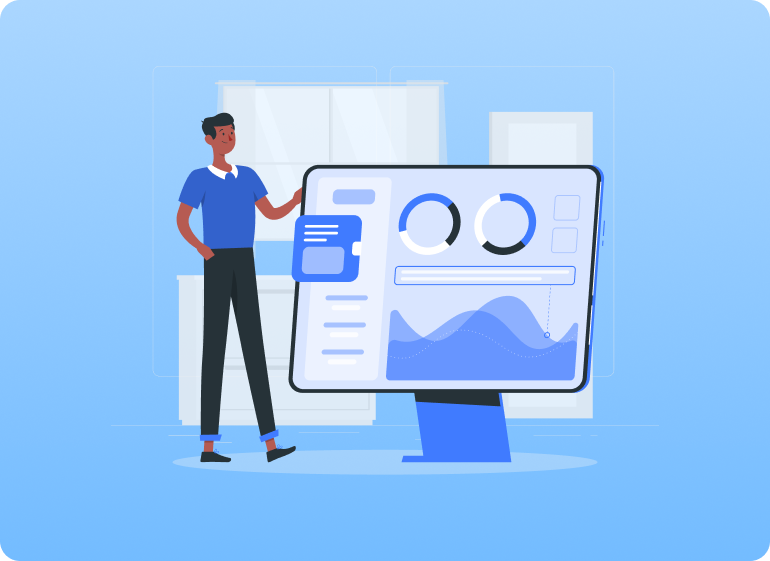Today’s world is almost entirely data driven; having top-notch data reporting tools can make or break your business. The popular leading business analytics software Microsoft Power BI ensures that you are equipped to always make data-driven decisions.
With Power BI, users can turn their data into actionable insights and interactive visualizations. Whether you’re an end-user creating dynamic reports or a developer embedding powerful analytics, you’ll always have the most tailored solutions for all your data needs.
In this post, we’ll explore the differences between the main Power BI products: Power BI and Power BI Embedded, so that you can make an informed decision on which one best fits your needs.
An Overview of Power BI
Power BI is a powerful business analytics solution that allows users to connect to a wide range of data sources. They can access the solution on-premises or in the cloud, and the solution enables them to easily clean and organize their data for analysis. The software also has intuitive data preparation and modeling tools that provide users with the ability to create dynamic visualizations and interactive reports.
In short, the software’s core functions are data connectivity, preparation, modeling, and report creation. These are comprehensive business intelligence solutions designed to help businesses analyze, visualize, and share insights from their data—which make Power BI a powerful asset for organizations of all sizes.
Let’s go over the key features of Power BI that make it such a popular choice.
Key Features of Power BI:

Data Connectivity
Power BI can connect to various databases, online services, and on-premises data sources, which means flexibility for seamless integration and real-time access to insights across a variety of channels.

Data Preparation
Power BI helps users clean, shape, and transform raw data into usable formats with its built-in tools. This level of customization results in high-quality inputs that are more accurate for data analysis.

Data Modeling
Through Power BI, users can build strong data models that create interactive visualizations and drive better decision-making.

Report Creation
Power BI helps create dynamic, interactive reports and dashboards, which users can then easily share with their teams or roll out for org-wide communication.
An Overview of Power BI Embedded
Power BI Embedded, another component of Microsoft Power BI, is a cloud-based platform that allows developers to embed interactive reports and visualizations into their custom applications.
While Power BI is mainly designed for end-users such as business analysts and data scientists, Power BI Embedded is aimed at developers who want to integrate the power of Power BI into their own applications. It enables organizations to connect their own custom applications, websites, and portals to Power BI’s powerful analytics system, which lets end-users view reports and dashboards without needing their own Power BI account.
Let’s look at the key features of Power BI Embedded.

What’s the Difference?
Power BI and Power BI Embedded differ mainly in that they cater to different needs and use cases. Power BI is designed for business analysts and uses a subscription pricing model, while Power BI Embedded targets developers with a pay-per-usage model. Power BI offers advanced features like data modeling, which are partially available in Power BI Embedded. Further, Power BI Embedded supports more customization and on-premises deployment, giving developers control over reports and data storage. Both tools excel in data analysis and visualization.
While both Power BI and Power BI Embedded offer powerful data analytics solutions, there are a few key differences that set them apart.

User Interface
- Power BI: Is designed for end-users, and offers a user-friendly interface to create, view, and share all reports.
- Power BI Embedded: Is designed for developers to embed Power BI capabilities into custom applications, which enables end-users to interact with reports within the application itself.

Access
- Power BI: All reports can be accessed via the Power BI web portal or mobile app.
- Power BI Embedded: All reports are integrated directly into custom applications, websites, or portals, which provides a seamless experience for end-users.

Licensing
- Power BI: Requires individual user licenses, making it an ideal tool for teams or organizations that need direct access to the platform for end-users.
- Power BI Embedded: Utilizes a capacity-based pricing model that provides dedicated cloud resources, making it ideal for developers embedding analytics for other audiences.

Customization
- Power BI: Offers in-service customization options for end-users who want tailored reports and dashboards.
- Power BI Embedded: Offers developers extensive customization options, allowing all embedded reports to align with the branding and user experience of the host application.
The Bottom Line
Making a decision between using Power BI and Power BI Embedded will depend on the specific needs of your organization. Power BI is a great solution for end-users that are seeking a comprehensive, user-friendly platform for data analysis and visualization. On the other hand, Power BI Embedded is ideal for developers looking to integrate powerful analytics into their custom applications while still having access to flexibility and scalability. Understanding the differences between these two services will help you make an informed decision that’ll help guide your business toward long-term success.


 Brian DeLuca
Brian DeLuca 


